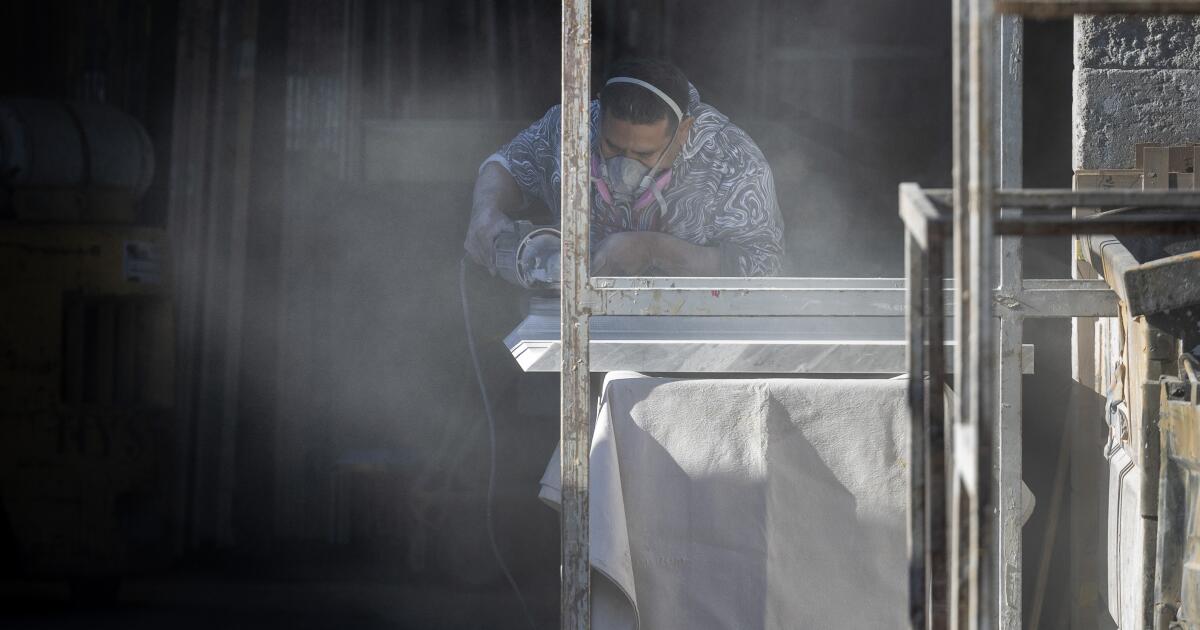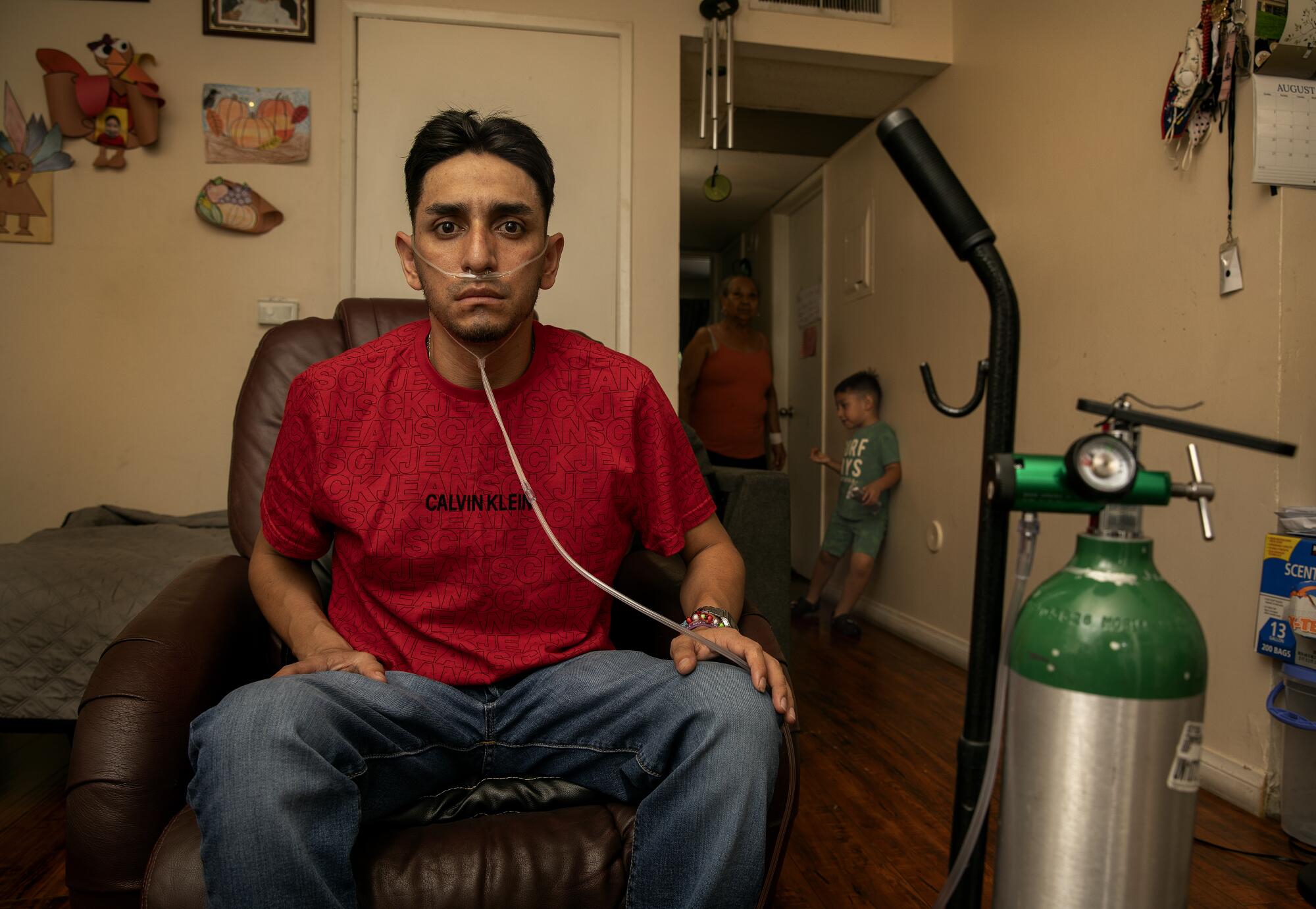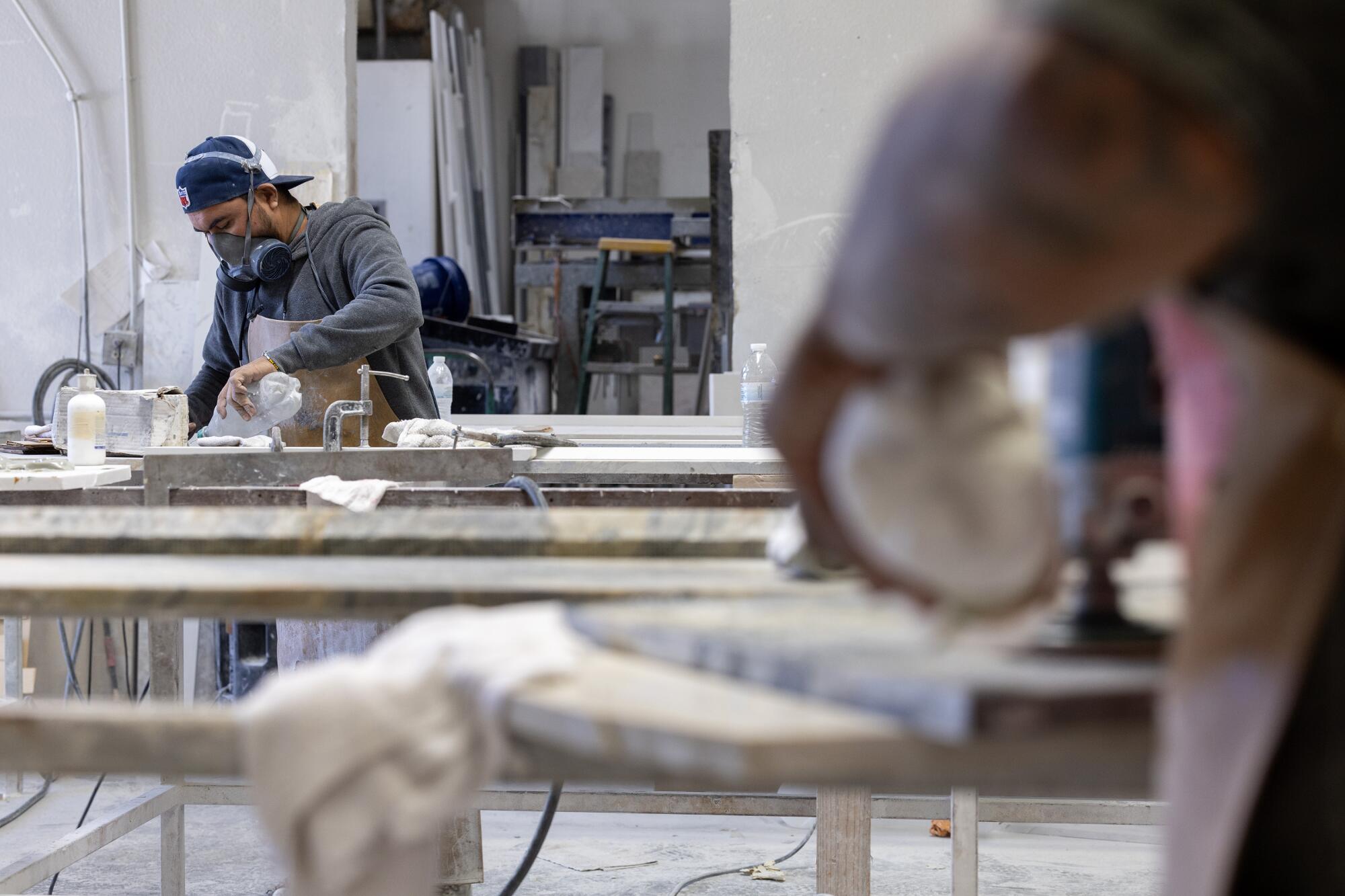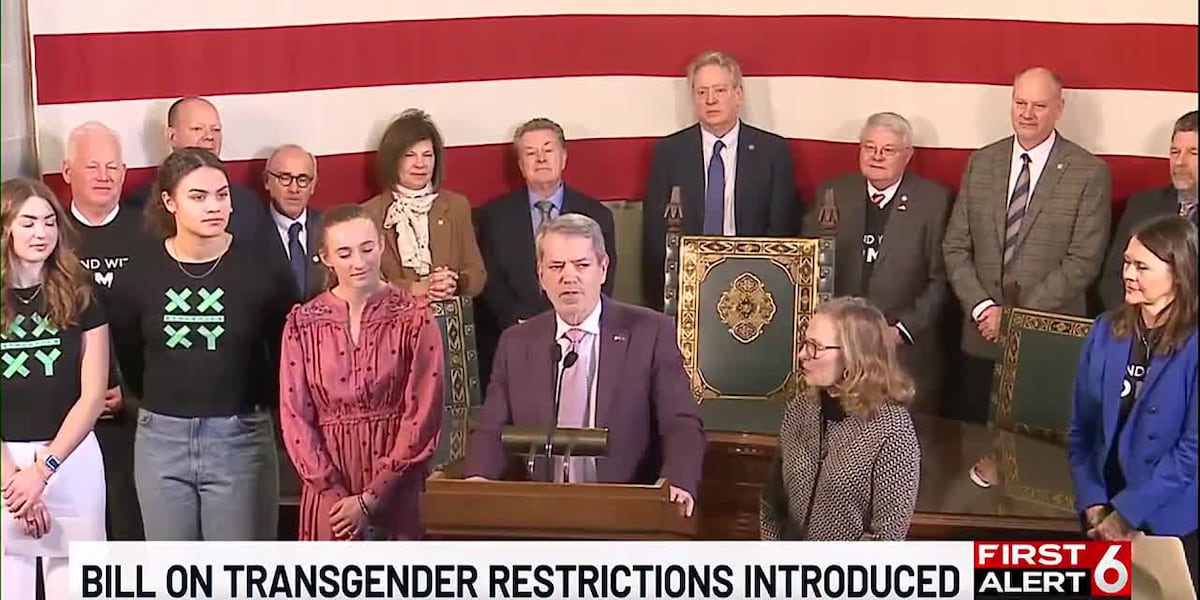Science
California workers died of a preventable disease. The threat was known years earlier

When Wendy Solano first heard the word “silicosis,” her husband Jose Raul Garcia Leon was already suffering from the incurable disease that would kill him.
After immigrating from Mexico, the father of three had provided for his family by cutting countertops. His illness began as a dry cough — something the couple had chalked up to allergies or the changing weather — and rapidly became so debilitating that he grew exhausted trying to speak, Solano said.
Leon died months after joining the waitlist for a lung transplant. Near the end, he could no longer speak, his lungs irreparably damaged by the pale dust that coated his clothes and head when he returned from work.
Wendy Solano stands in front of an altar for her late husband Jose Raul Garcia Leon, who died in February from silicosis.
(Dania Maxwell / Los Angeles Times)
He was 46 years old.
The deaths of workers like Leon, some barely at middle age, have alarmed California lawmakers and regulators as dozens of cases of the suffocating illness have emerged among people who cut and grind countertops. Physicians have linked the silicosis outbreak to the booming demand for engineered stone, a synthetic material much higher in lung-scarring silica than natural granite or marble.
Yet the threat of silicosis is far from a new one, known for centuries as a hazard to workers breathing in tiny particles of crystalline silica. And more than a decade before Leon died, researchers had already raised alarms about the renewed threat of silicosis specifically among workers cutting engineered stone, which has surged in popularity since the turn of the century.
Many experts said the risks should have been anticipated and averted long before young men like Leon started dying.
“It still astounds me as to how glacial the pace has been” to tackle the problem, said Dr. Ryan Hoy, who leads an occupational respiratory disease clinic at Alfred Hospital in Melbourne, Australia.
“This is an epidemic of silicosis — a completely preventable lung disease — in this industry all for the sake of having a fashionable kitchen countertop,” Hoy said. Regulators should be looking at the risks of any new material, he said, not “waiting until patients and workers are dying and then doing something.”
But California physicians and scientists trying to raise alarms have faced a host of obstacles. Silicosis takes years to become apparent after workers are exposed, and the disease has often been mistaken for other ailments by physicians unaware of its modern resurgence. Immigrant workers may hesitate to seek medical care, preventing their illnesses from being detected promptly by health officials.
Dozens of California cases have been tallied so far, but that’s “just the tip of the iceberg,” said Dr. Amy Heinzerling, chief of the emerging workplace hazards unit at the California Department of Public Health. Regulators estimate the state is home to more than 800 shops where engineered stone is readied for installation in kitchens and bathrooms — and believe the bulk are out of compliance with silica rules. “There are almost certainly more cases out there that we don’t know about.”
::
Silicosis is one of the oldest occupational diseases on the globe. The deadly toll of dust on miners and stonecutters was detailed by European scholars in the 1500s and 1700s. During the Great Depression, silicosis killed hundreds of workers — most of them Black men — who drilled a West Virginia tunnel, a disaster that spurred a national campaign by labor officials to “Stop Silicosis.”
Deaths from silicosis plummeted in the U.S. between 1968 and 2002, with a 93% decline in the rate of silicosis deaths in that time, according to the Centers for Disease Control and Prevention. The International Labour Organization and the World Health Organization launched a program to eliminate silicosis worldwide by 2030.
But the threat never disappeared, afflicting workers who were sandblasting denim and tombstones and toiling in mines. And as new forms of silica exposure arose, that goal of eliminating silicosis by 2030 has become an unlikely one, said Dr. Francisco Santos-O’Connor, senior specialist in occupational safety and health at the ILO.

A stylish kitchen featuring white Caesarstone countertops.
(Mariah Tauger / Los Angeles Times)
Physicians have linked many recent cases to the rise of engineered stone in the international market. In the 1970s, an Italian entrepreneur developed the technology to bind crushed stone together with resin and produce slabs of artificial stone. Among the first companies to manufacture it was Caesarstone, which set up a factory in 1987 at an Israeli kibbutz.
Doctors in Israel began to spot silicosis cases among such workers between 1997 and 2001, but “these were scattered events,” they wrote in the medical journal Chest, and “we did not appreciate the nature of the outbreak” at first. By the time they published their findings in 2012, they had found more than two dozen cases among stonecutters working with a “relatively new, artificial, decorative stone product.”
At that point, silicosis cases had also been detected in Spain, where engineered stone had gone into production. More cases arose in Italy and Australia as well.
Hoy said that long before stonecutters started struggling to breathe, the sheer amount of silica in many kinds of engineered stone — upwards of 90% — should have made it obvious that the material was risky to cut and grind, especially in workplaces without sophisticated measures to control dust.
“Silica is an occupational hazard that’s been known about for well over a century … longer than asbestos, longer than tobacco smoking,” Hoy said. But as engineered stone grew into a global industry worth more than $20 billion, “all our worst fears have kept coming true.”
Physicians have been alarmed to see young men sickened after a decade or less of workplace exposure. In the U.S. and elsewhere, laborers cut the high-silica material in the same shops where they had toiled over marble or granite — and using the same methods, including “dry cutting” without any water to suppress dust.
The fabrication shops where workers cut and polish slabs are typically divorced from the engineered stone manufacturers that supply the material. That complicates information sharing and enforcement, said Dr. Robert Harrison, a public health medical officer with the California Department of Public Health.
The U.S. has tightened limits for how much silica workers should be exposed to, but “the real problem is that OSHA” — the federal Occupational Safety and Health Administration — “is incredibly underresourced,” said Dr. Cecile Rose, a pulmonologist at National Jewish Health in Denver. “They do not have enough funding to be able to go to all the workplaces” where silica could put people at risk.
Industry groups have placed the blame on unsafe practices by fabrication shops rather than the material itself. Facilities where regulations are not enforced have endangered workers by neglecting “fundamental safety precautions,” said Eric Rose, a spokesperson for the Stone Coalition, which includes manufacturers, fabricators and distributors across the country.
“Silicosis is almost entirely preventable,” he said. “Any contractor who adheres to Cal/OSHA guidelines can ensure the safe cutting of all types of stone, be it engineered or natural, with minimal risk to their workers.”
But scientists and regulators have grown concerned about whether recommended strategies such as wet cutting, proper ventilation and wearing respirator masks can do enough to protect workers from dust so high in silica. Cal/OSHA officials have generally described silicosis as preventable, but also caution that with 93% silica content, “safe use of engineered stone may not be possible” even with proper workplace practices.
In Australia, workplace safety officials recently recommended a total ban on engineered stone, calling it “the only way to ensure that another generation of Australian workers do not contract silicosis from such work.”
::
More than a decade ago, U.S. physicians began seeing reports from abroad about the risks of cutting engineered stone and realized that silicosis could soon afflict workers here.
Just a few months after a CDC blog post in 2014 warned of the possible threat, health officials in Texas learned that a 37-year-old worker was suffering from the disease — the first reported case tied to high-silica countertop cutting in North America, according to researchers.
Five years later, U.S. researchers had tallied 18 such cases in four states. Among them were six men from California, all working for the same company. Public health investigators found the first one using state data about hospital discharges, identifying a young man who had cut countertops for nearly a decade.
But researchers often do not get information about hospital discharges until a year or more later, Heinzerling said. By the time the researchers learned about that first patient, he had already died at the age of 38.

Leobardo Segura Meza suffers from silicosis, an incurable lung disease that has been afflicting workers who cut and polish engineered stone high in silica.
(Mel Melcon / Los Angeles Times)
This is an epidemic of silicosis — a completely preventable lung disease — in this industry all for the sake of having a fashionable kitchen countertop.
— Dr. Ryan Hoy, who leads a respiratory disease clinic in Melbourne, Australia
Scores of silicosis cases among California countertop workers have been reported since 2019, the bulk of them in Los Angeles County, where small workshops are tucked into industrial stretches of the San Fernando Valley. The numbers have rapidly escalated, with roughly half of the 93 known cases identified this year alone. At least 10 countertop workers across California have died of the disease.
Physicians fear many more cases have gone undetected. A study by researchers at UCLA and UC San Francisco found that among dozens of California countertop workers with silicosis, more than half were initially misdiagnosed with other ailments.
“They kept working. They kept being exposed. They were getting medical care that wasn’t the right medical care and it was delaying their actual diagnosis — and they were getting worse,” said Dr. Sheiphali Gandhi, a pulmonologist at UCSF. Part of the problem is many physicians “just don’t think that this can happen anymore.”
Many doctors do not routinely ask patients about the work they do. Even when cases of silicosis are recognized, California physicians haven’t been required to report them to health officials — something the public health department is now working to change.
Then there is the question of whether suffering workers see a doctor at all. Gandhi said California has more expansive health coverage for undocumented immigrants than many other states, where such workers might have more difficulty accessing medical care.

Countertop fabricators cut stone in a workshop in Sun Valley.
(Brian van der Brug / Los Angeles Times)
The National Institute for Occupational Safety and Health said it cannot track the number of silicosis cases tied to countertop cutting across the U.S. because health records don’t typically include the work done by patients. Nor is there a global system for tracking such threats, experts said. Cecile Rose and her colleague Dr. Jeremy T. Hua are building an international registry of silicosis cases to better understand the scope of the problem.
In Australia, which is now weighing a national ban on engineered stone, government leaders took action after workers began telling their stories. Among them was Anthony White, a Queensland stonecutter whose illness and death at age 36 were widely covered there.
But in the U.S., many immigrants suffering from silicosis were initially reluctant to speak publicly, Gandhi said. The tiny shops where countertop cutters work are not generally unionized, leaving employees fearful of losing their jobs and unlikely to complain to government agencies, Cal/OSHA officials said in a report.
Changes are now in the works in California: After finding widespread violations of a state standard meant to protect workers from silica, Cal/OSHA is hustling to draft emergency rules. If employers don’t follow them, the agency says it could consider a ban on engineered stone.
State lawmakers are vowing to take action. Los Angeles County is also backing stronger standards to protect workers and considering a possible ban.
Some families are going after the makers of engineered stone in court. Solano is among the plaintiffs in dozens of California lawsuits that argue the slabs are “inherently hazardous.”
Manufacturers have fought such cases: Caesarstone denied that Solano and her children were damaged by “any act or omission” by the company. Cosentino said California courts lacked jurisdiction because the company “has never conducted any business in California.”
In Spain, however, a Cosentino executive admitted in court that its failure to disclose risks caused serious injury to five workers and agreed to pay them and their families more than $1 million. Cosentino said in a statement that it was found liable only for providing “insufficient technical information” to a particular fabrication shop.

Wendy Solano shows a tattoo she got after her husband, Jose Raul Garcia Leon, died of silicosis.
(Dania Maxwell / Los Angeles Times)
Leon died in February after being disconnected from a ventilator at a Los Angeles hospital, his wife said. The couple, who had met when Solano was a teenager, were together for two and a half decades and married in a church. Leon had been a devoted father who showed up at school dances and games and loved dogs and cars and soccer, she said. For a long time, he loved his job too.
Before he died, he knew that Solano was going to pursue the lawsuit against engineered stone manufacturers. She has pressed forward, she said, because her husband was not alone.
“There are many other people whose lives are in danger, because this is not going to stop,” she said.
It’s long been known that “if you inhale high levels of silica dust, you’re going to get silicosis,” said Dr. Paul Blanc, an occupational lung disease specialist at UCSF. But “there is a kind of cyclical amnesia in occupational health where we’re aware of a problem and we give some attention to it, and then there’s a forgetting.”
And, he said, “the economic interests are certainly in favor of forgetting.”
Times staff writer Kate Linthicum contributed to this report.

Science
There's a reason you can't stop doomscrolling through L.A.'s fire disaster

Even for those lucky enough to get out in time, or to live outside the evacuation zones, there has been no escape from the fires in the Los Angeles area this week.
There is hardly a vantage point in the city from which flames or plumes of smoke are not visible, nowhere the scent of burning memories can’t reach.
And on our screens — on seemingly every channel and social media feed and text thread and WhatsApp group — an endless carousel of images documents a level of fear, loss and grief that felt unimaginable here as recently as Tuesday morning.
Even in places of physical safety, many in Los Angeles are finding it difficult to look away from the worst of the destruction online.
“To me it’s more comfortable to doomscroll than to sit and wait,” said Clara Sterling, who evacuated from her home Wednesday. “I would rather know exactly where the fire is going and where it’s headed than not know anything at all.”
A writer and comedian, Sterling is — by her own admission — extremely online. But the nature of this week’s fires make it particularly hard to disengage from news coverage and social media, experts said.
For one, there’s a material difference between scrolling through images of a far-off crisis and staying informed about an active disaster unfolding in your neighborhood, said Casey Fiesler, an associate professor specializing in tech ethics at the University of Colorado Boulder.
“It’s weird to even think of it as ‘doomscrolling,’ ” she said. “When you’re in it, you’re also looking for important information that can be really hard to get.”
When you share an identity with the victims of a traumatic event, you’re more likely both to seek out media coverage of the experience and to feel more distressed by the media you see, said Roxane Cohen Silver, distinguished professor of psychological science at UC Irvine.
For Los Angeles residents, this week’s fires are affecting the people we identify with most intimately: family, friends and community members. They have consumed places and landmarks that feature prominently in fond memories and regular routines.
The ubiquitous images have also fueled painful memories for those who have lived through similar disasters — a group whose numbers have increased as wildfires have grown more frequent in California, Silver said.
This she knows personally: She evacuated from the Laguna Beach fires in 1993, and began a long-term study of that fire’s survivors days after returning to her home.
“Throughout California, throughout the West, throughout communities that have had wildfire experience, we are particularly primed and sensitized to that news,” she said. “And the more we immerse ourselves in that news, the more likely we are to experience distress.”
Absorption in these images of fire and ash can cause trauma of its own, said Jyoti Mishra, an associate professor of psychiatry at UC San Diego who studied the long-term psychological health of survivors of the 2018 Camp fire.
The team identified lingering symptoms of post-traumatic stress disorder, depression and anxiety both among survivors who personally experienced fire-related trauma such as injury or property loss, and — to a smaller but still significant degree — among those who indirectly experienced the trauma as witnesses.
“If you’re witnessing [trauma] in the media, happening on the streets that you’ve lived on and walked on, and you can really put yourself in that place, then it can definitely be impactful,” said Mishra, who’s also co-director of the UC Climate Change and Mental Health Council. “Psychology and neuroscience research has shown that images and videos that generate a sense of personal meaning can have deep emotional impacts.”
The emotional pull of the videos and images on social media make it hard to look away, even as many find the information there much harder to trust.
Like many others, Sterling spent a lot of time online during the early days of the COVID-19 pandemic. Back then, Sterling said, the social media environment felt decidedly different.
“This time around I think I feel less informed about what’s going on because there’s been such a big push toward not fact-checking and getting rid of verified accounts,” she said.
The rise of AI-generated images and photos has added another troubling kink, as Sterling highlighted in a video posted to TikTok early Thursday.
“The Hollywood sign was not on fire last night. Any video or photos that you saw of the Hollywood sign on fire were fake. They were AI generated,” she said, posting from a hotel in San Diego after evacuating.
Hunter Ditch, a producer and voice actor in Lake Balboa, raised similar concerns about the lack of accurate information. Some social media content she’s encountered seemed “very polarizing” or political, and some exaggerated the scope of the disaster or featured complete fabrications, such as that flaming Hollywood sign.
The spread of false information has added another layer of stress, she said. This week, she started turning to other types of app — like the disaster mapping app, Watch Duty — to track the spreading fires and changing evacuation zones.
But that made her wonder: “If I have to check a whole other app for accurate information, then what am I even doing on social media at all?”
Science
Pink Fire Retardant, a Dramatic Wildfire Weapon, Poses Its Own Dangers

From above the raging flames, these planes can unleash immense tankfuls of bright pink fire retardant in just 20 seconds. They have long been considered vital in the battle against wildfires.
But emerging research has shown that the millions of gallons of retardant sprayed on the landscape to tame wildfires each year come with a toxic burden, because they contain heavy metals and other chemicals that are harmful to human health and the environment.
The toxicity presents a stark dilemma. These tankers and their cargo are a powerful tool for taming deadly blazes. Yet as wildfires intensify and become more frequent in an era of climate change, firefighters are using them more often, and in the process releasing more harmful chemicals into the environment.
Some environmental groups have questioned the retardants’ effectiveness and potential for harm. The efficiency of fire retardant has been hard to measure, because it’s one of a barrage of firefighting tactics deployed in a major fire. After the flames are doused, it’s difficult to assign credit.
The frequency and severity of wildfires has grown in recent years, particularly in the western United States. Scientists have also found that fires across the region have become faster moving in recent decades.
There are also the longer-term health effects of exposure to wildfire smoke, which can penetrate the lungs and heart, causing disease. A recent global survey of the health effects of air pollution caused by wildfires found that in the United States, exposure to wildfire smoke had increased by 77 percent since 2002. Globally, wildfire smoke has been estimated to be responsible for up to 675,000 premature deaths per year.
Fire retardants add to those health and environmental burdens because they present “a really, really thorny trade-off,” said Daniel McCurry, an assistant professor of civil and environmental engineering at the University of Southern California, who led the recent research on their heavy-metal content.
The United States Forest Service said on Thursday that nine large retardant-spraying planes, as well as 20 water-dropping helicopters, were being deployed to fight the Southern California fires, which have displaced tens of thousands of people. Several “water scooper” amphibious planes, capable of skimming the surface of the sea or other body of water to fill their tanks, are also being used.
Two large DC-10 aircraft, dubbed “Very Large Airtankers” and capable of delivering up to 9,400 gallons of retardant, were also set to join the fleet imminently, said Stanton Florea, a spokesman for the National Interagency Fire Center in Boise, Idaho, which coordinates national wildland firefighting efforts across the West.
Sprayed ahead of the fire, the retardants coat vegetation and prevent oxygen from allowing it to burn, Mr. Florea said. (Red dye is added so firefighters can see the retardant against the landscape.) And the retardant, typically made of salts like ammonium polyphosphate, “lasts longer. It doesn’t evaporate, like dropping water,” he said.
The new research from Dr. McCurry and his colleagues found, however, that at least four different types of heavy metals in a common type of retardant used by firefighters exceeded California’s requirements for hazardous waste.
Federal data shows that more than 440 million gallons of retardant were applied to federal, state, and private land between 2009 and 2021. Using that figure, the researchers estimated that between 2009 and 2021, more than 400 tons of heavy metals were released into the environment from fire suppression, a third of that in Southern California.
Both the federal government and the retardant’s manufacturer, Perimeter Solutions, have disputed that analysis, saying the researchers had evaluated a different version of the retardant. Dan Green, a spokesman for Perimeter, said retardants used for aerial firefighting had passed “extensive testing to confirm they meet strict standards for aquatic and mammalian safety.”
Still, the findings help explain why concentrations of heavy metals tend to surge in rivers and streams after wildfires, sometimes by hundreds of times. And as scrutiny of fire suppressants has grown, the Forestry Service has set buffer zones surrounding lakes and rivers, though its own data shows retardant still inadvertently drifts into those waters.
In 2022, the environmental nonprofit Forest Service Employees for Environmental Ethics sued the government in federal court in Montana, demanding that the Forest Service obtain a permit under the Clean Water Act to cover accidental spraying into waterways.
The judge ruled that the agency did indeed need to obtain a permit. But it allowed retardant use to continue to protect lives and property.
Science
2024 Brought the World to a Dangerous Warming Threshold. Now What?

Source: Copernicus/ECMWF
Note: Temperature anomalies relative to 1850-1900 averages.
At the stroke of midnight on Dec. 31, Earth finished up its hottest year in recorded history, scientists said on Friday. The previous hottest year was 2023. And the next one will be upon us before long: By continuing to burn huge amounts of coal, oil and gas, humankind has all but guaranteed it.
The planet’s record-high average temperature last year reflected the weekslong, 104-degree-Fahrenheit spring heat waves that shuttered schools in Bangladesh and India. It reflected the effects of the bathtub-warm ocean waters that supercharged hurricanes in the Gulf of Mexico and cyclones in the Philippines. And it reflected the roasting summer and fall conditions that primed Los Angeles this week for the most destructive wildfires in its history.
“We are facing a very new climate and new challenges, challenges that our society is not prepared for,” said Carlo Buontempo, director of the Copernicus Climate Change Service, the European Union monitoring agency.
But even within this progression of warmer years and ever-intensifying risks to homes, communities and the environment, 2024 stood out in another unwelcome way. According to Copernicus, it was the first year in which global temperatures averaged more than 1.5 degrees Celsius, or 2.7 degrees Fahrenheit, above those the planet experienced at the start of the industrial age.
For the past decade, the world has sought to avoid crossing this dangerous threshold. Nations enshrined the goal in the 2015 Paris agreement to fight climate change. “Keep 1.5 alive” was the mantra at United Nations summits.
Yet here we are. Global temperatures will fluctuate somewhat, as they always do, which is why scientists often look at warming averaged over longer periods, not just a single year.
But even by that standard, staying below 1.5 degrees looks increasingly unattainable, according to researchers who have run the numbers. Globally, despite hundreds of billions of dollars invested in clean-energy technologies, carbon dioxide emissions hit a record in 2024 and show no signs of dropping.
One recent study published in the journal Nature concluded that the absolute best humanity can now hope for is around 1.6 degrees of warming. To achieve it, nations would need to start slashing emissions at a pace that would strain political, social and economic feasibility.
But what if we’d started earlier?
By spewing heat-trapping gases into the atmosphere, humankind has lifted global temperatures to record highs.
If nations had started reducing emissions in 2005, they could have made gradual cuts to limit warming to 1.5 degrees.
Starting in 2015, when the Paris agreement was adopted, would have required steeper cuts.
Starting today would require cuts so drastic as to appear essentially impossible.
“It was guaranteed we’d get to this point where the gap between reality and the trajectory we needed for 1.5 degrees was so big it was ridiculous,” said David Victor, a professor of public policy at the University of California, San Diego.
The question now is what, if anything, should replace 1.5 as a lodestar for nations’ climate aspirations.
“These top-level goals are at best a compass,” Dr. Victor said. “They’re a reminder that if we don’t do more, we’re in for significant climate impacts.”
The 1.5-degree threshold was never the difference between safety and ruin, between hope and despair. It was a number negotiated by governments trying to answer a big question: What’s the highest global temperature increase — and the associated level of dangers, whether heat waves or wildfires or melting glaciers — that our societies should strive to avoid?
The result, as codified in the Paris agreement, was that nations would aspire to hold warming to “well below” 2 degrees Celsius while “pursuing efforts” to limit it to 1.5 degrees.
Even at the time, some experts called the latter goal unrealistic, because it required such deep and rapid emissions cuts. Still, the United States, the European Union and other governments adopted it as a guidepost for climate policy.
Christoph Bertram, an associate research professor at the University of Maryland’s Center for Global Sustainability, said the urgency of the 1.5 target spurred companies of all kinds — automakers, cement manufacturers, electric utilities — to start thinking hard about what it would mean to zero out their emissions by midcentury. “I do think that has led to some serious action,” Dr. Bertram said.
But the high aspiration of the 1.5 target also exposed deep fault lines among nations.
China and India never backed the goal, since it required them to curb their use of coal, gas and oil at a pace they said would hamstring their development. Rich countries that were struggling to cut their own emissions began choking off funding in the developing world for fossil-fuel projects that were economically beneficial. Some low-income countries felt it was deeply unfair to ask them to sacrifice for the climate given that it was wealthy nations — and not them — that had produced most of the greenhouse gases now warming the world.
“The 1.5-degree target has created a lot of tension between rich and poor countries,” said Vijaya Ramachandran, director for energy and development at the Breakthrough Institute, an environmental research organization.
Costa Samaras, an environmental-engineering professor at Carnegie Mellon University, compared the warming goals to health officials’ guidelines on, say, cholesterol. “We don’t set health targets on what’s realistic or what’s possible,” Dr. Samaras said. “We say, ‘This is what’s good for you. This is how you’re going to not get sick.’”
“If we were going to say, ‘Well, 1.5 is likely out of the question, let’s put it to 1.75,’ it gives people a false sense of assurance that 1.5 was not that important,” said Dr. Samaras, who helped shape U.S. climate policy from 2021 to 2024 in the White House Office of Science and Technology Policy. “It’s hugely important.”
Scientists convened by the United Nations have concluded that restricting warming to 1.5 degrees instead of 2 would spare tens of millions of people from being exposed to life-threatening heat waves, water shortages and coastal flooding. It might mean the difference between a world that has coral reefs and Arctic sea ice in the summer, and one that doesn’t.
Each tiny increment of additional warming, whether it’s 1.6 degrees versus 1.5, or 1.7 versus 1.6, increases the risks. “Even if the world overshoots 1.5 degrees, and the chances of this happening are increasing every day, we must keep striving” to bring emissions to zero as soon as possible, said Inger Anderson, the executive director of the United Nations Environment Program.
Officially, the sun has not yet set on the 1.5 target. The Paris agreement remains in force, even as President-elect Donald J. Trump vows to withdraw the United States from it for a second time. At U.N. climate negotiations, talk of 1.5 has become more muted compared with years past. But it has hardly gone away.
“With appropriate measures, 1.5 Celsius is still achievable,” Cedric Schuster, the minister of natural resources and environment for the Pacific island nation of Samoa, said at last year’s summit in Azerbaijan. Countries should “rise to the occasion with new, highly ambitious” policies, he said.
To Dr. Victor of U.C. San Diego, it is strange but all too predictable that governments keep speaking this way about what appears to be an unachievable aim. “No major political leader who wants to be taken seriously on climate wants to stick their neck out and say, ‘1.5 degrees isn’t feasible. Let’s talk about more realistic goals,’” he said.
Still, the world will eventually need to have that discussion, Dr. Victor said. And it’s unclear how it will go.
“It could be constructive, where we start asking, ‘How much warming are we really in for? And how do we deal with that?’” he said. “Or it could look very toxic, with a bunch of political finger pointing.”
Methodology
The second chart shows pathways for reducing carbon emissions that would have a 66 percent chance of limiting global warming this century to 1.5 degrees Celsius above the preindustrial average.
-

 Business1 week ago
Business1 week agoThese are the top 7 issues facing the struggling restaurant industry in 2025
-

 Culture1 week ago
Culture1 week agoThe 25 worst losses in college football history, including Baylor’s 2024 entry at Colorado
-

 Sports1 week ago
Sports1 week agoThe top out-of-contract players available as free transfers: Kimmich, De Bruyne, Van Dijk…
-

 Politics1 week ago
Politics1 week agoNew Orleans attacker had 'remote detonator' for explosives in French Quarter, Biden says
-

 Politics1 week ago
Politics1 week agoCarter's judicial picks reshaped the federal bench across the country
-

 Politics6 days ago
Politics6 days agoWho Are the Recipients of the Presidential Medal of Freedom?
-

 Health5 days ago
Health5 days agoOzempic ‘microdosing’ is the new weight-loss trend: Should you try it?
-

 World1 week ago
World1 week agoIvory Coast says French troops to leave country after decades















